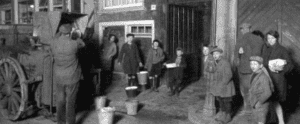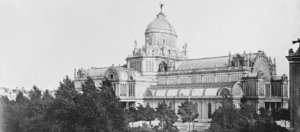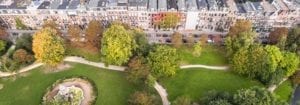Annabelle Slingerland
Leiden, the Netherlands

Times of confusion and uncertainty can also be fruitful grounds for seeds to root, rise, and bloom. One such seed was Dr. Samuel Sarphati, who created New Amsterdam on the banks of the river Amstel.
Amsterdam in the early nineteenth century was already renowned for its prosperous canal belts, streets lit with gas lamps, fresh drinking water, copious dinners, spices, and art. Left out, however, were the lower classes that had barely survived the scourge of epidemics, the slumps of poverty, and the scars of Napoleon’s wars, oppressive regulations, and ruinous continental ban. Abattoir animals, orphans, wounded soldiers, and drunken men wended their way around heaps of waste and through polluted canals to find food and shelter in collapsed warehouses. Charities were few, their efforts insufficient.
From the front door of the Jewish upper class houses, it was a short walk to the Jewish middle class neighborhood around the Jodenbreestraat, and further along a dark alley, to the area where most of the people lived. Births were registered in the Portuguese synagogue attached to the Jewish quarter. On February 2, 1813, Emmanuel Sarphati registered his firstborn son, Samuel, who was born January 31, 1813.
Family history and descent
Samuel would be raised in a closely-knit Sephardic Jewish community with strong family ties and traditions that read the Torah, married, and did good deeds. His grandmother had run a bath house until the age of eighty-five; his father was a tobacco merchant; and there were five siblings and other in-laws integrated into Samuel’s family and professional life. His connections further broadened when he married Abigael Mendes de Leon, whose father performed good works anonymously. Samuel’s extended family would broaden his horizon as he surrounded himself with kindred spirits who were energetic and driven like himself, and treated everyone as equal. He would later have three servants, two Christian and one Jewish.
Medical school

Samuel learned Latin and became an intern at the apothecary Coronel that provided medicines for doctors and chemicals for laboratories. As he attended chemistry and botany lectures at the Athenaeum Illustre, an epidemic of cholera hit Amsterdam. It had swept across the Ganges Delta (1817) through Southeast Asia and to the Middle East; and was followed by a second pandemic (1826) that hit Moscow (1830). In 1832 this so-called Asian Vomit reached Amsterdam, where Samuel must have been preparing elixirs in the apothecary around the corner from the hastily installed cholera hospital, and witnessed the many casualties and the economic recession that followed.
In 1833 Samuel moved to Leyden, where his father would finance his education at the university. He refrained from fraternities but joined societies for agriculture, science, and apothecary. He graduated cum laude in June 1839 and presented his doctoral thesis that year.
Medical practice
By the time he returned to Amsterdam, the economic recession had passed and fresh winds uplifted the city. The Dutch Society of Commerce had moved from The Hague to Amsterdam, the first railway was built, there was a new zoo, modern gaslights, and photography arrived from Paris. Cultures merged, and so for example a Catholic church arose next to the Jewish Synagogue where Spinoza had lived—a situation unthinkable before. Birth rates increased, death rates declined, and life expectancy rose. Samuel’s parents moved to the Bloemmarkt, a picturesque affluent neighborhood, and he moved back in with them. He briefly started his own medical practice, but then decided that his mission was to care for the poor of the Sephardic Jewish community. He divided his time between home visits and the hospital and found abysmal conditions: doctors risking their lives among indigent patients with cholera or typhus, and one of his colleagues developing gangrene from typhoid resulting in an amputation of his leg. Soon realizing that his medical knowledge would only have a marginal effect on his patients’ lives, Samuel broadened his scope and skills so he could invent and build on a larger scale.
How he was able to make changes

He became a member of the administration in Amsterdam and of a society for building and civil engineering. As the city council could not afford the costs of innovation, he befriended people who could do so. He wrote letters to suggest founding an exposition on agriculture, a school of commerce, support swimming, and develop preventive measures when outbreaks of smallpox (1843) or “contagious fevers” (1846) resurfaced. He foresaw that if the Dutch did not buy into new technology, foreign enterprises would take over, as when Amsterdam’s gaslight and water sanitation had fallen into British hands. He emphasized the damaging effects and self-perpetuating cycle of begging and living off charity. As his professorship in chemistry fell through and he no longer had to struggle as a physician to the poor, he was free to focus on what was really important—to himself build what he had suggested to others.
The changes he made
At the age of thirty-four, his determination won. With funds from his family, friends, and other citizens, he developed urinals, warehouses, stables, infrastructure for streets, and better water wells. He visited every corner of Amsterdam and drew maps for a new city plan. By 1847 public hygiene and sanitation improved, domestic waste and street refuse was being converted into compost, land and property prices increased, and the price of food was lowered and its quality improved. The city became cleaner, healthier, wealthier, and regained its beauty and attractiveness.
A cholera epidemic in 1848 helped further his aims. Instead of quarantining people, policies requiring clean water were instituted. It was the time of the industrial revolution, and Samuel obtained the support of the Dutch ministry to improve the living conditions of the lower class. He believed that without development there would be no affluence, no knowledge without good education, and no effective workforce without healthy food. He concluded that drunkenness out of hunger stood in the way of progress; achieved a reduction of taxes on meat; founded the first flour and bread factory, and a school of commerce where students could learn craftsmanship and where he was one of the teachers. He obtained permission to develop the first waste and manure processing company, which collected waste and turned it into compost for agriculture.

When city councils or government were ineffective, progress would have to come from entrepreneurs. He felt that workers needed to be paid well and he supported the rise of unions. In 1851 he visited the World Exhibition in London’s Crystal Palace and was impressed by Queen Victoria and Prince Albert’s visionary and humanitarian attitude toward innovation and private funding. He also realized that city gates and fortifications had become unnecessary and supported expanding the city outward, enlarging lanes, and creating parks. He helped found a bank for mortgages and a bank in Surinam to convert slavery to paid labor. In 1964, he built the Palace for Folk Industry with the Dutch royal family as its patron. Do not complain, he said, work and do not ask for charity to feed the poor, but provide them work. The Palace received 200,000 visitors in its first half-year and generated 65,000 guilders. He received permission to build the Amstel Hotel, a new sewage system was built to send waste
underground by air pressure, the Surinam bank opened, and the Palace of Industry hosted the fiftieth anniversary of the victory over Napoleon.
His efforts came to an end when the cattle plague swept England, riots broke out in the financial district of London, and cholera came to Amsterdam. Sarphati fell ill, stayed home for a week, and died on June 23, 1866.
His legacy
Sarphati had reanimated the city and set off a chain reaction among his successors. His efforts helped combat the origins of poverty and disease. Schools were modeled after his own; the Amstel Hotel opened in 1867 and is still thriving today. He wished to expand a healthy city without walls, with greenery, space, sanitation, and education. In Amsterdam there is a park, a street, and a pumping station named after him, as well as the Sarphati Memorial bearing the inscription “Founder of New Amsterdam,” and the Dr. Sarphatihuis home for the elderly. In 2013, the Sarphati Sanitation Awards were instituted followed by the Sarphati Sanitation Symposium to support entrepreneurial initiatives in new populations anywhere in the world. Currently the Sarphati Cohort of the Public Health Services looks into the circumstances contributing to disease in Amsterdam’s children. Of particular interest for the era we live in today, “Sarphati Hand Alcohol” is manufactured in a brewery that has turned to mass production of alcohol-based hand wash.
Further reading suggestions
- Aerts, R., de Rooy P. (redactie). Geschiedenis van Amsterdam, deel 3 (1813-1900) ‘Hoofdstad in Aanbouw.’ 2006. (Volume 3 in a book series on the history of Amsterdam)
- Amsterdam Experiences, The Curious Biography of Samuel Sarphati, 2019 (English) https://medium.com/@info_78345/the-curious-biography-of-sarphati-223133e5674a
- Amsterdam History, Historical Maps of Amsterdam 1820-1866 http://www.amsterdamhistorie.nl/kaarten/kaarten.html?imagenaam=amsterdam
- Aquatec, Curing Amsterdam’s Bad Breath, Sarphati Sanitation Awards, Amsterdam Water Week https://www.aquatechtrade.com/news/article/do-you-know-the-next-samuel-sarphati/
- Avandis, ‘Sarphati handalcohol’ https://www.avandis.nl/wp-content/uploads/2020/03/200320-Avandis-persbericht-Avandis-gaat-handalcohol-produceren-voor-Nederlandse-ziekenhuizen.pdf.pdf
- Bottenheim, S. Dr. Samuel Sarphati. 1945. (Book).
- de Bruin W. Samuel Sarphati, Schepper van een nieuwe stad, Historisch Nieuwsblad nt 8/2010. (Article in a Historical Magazine)
- Digital Library on the Palace of Folk Industry, Samuel Sarphati https://www.digitaleetalages.nl/thema/amsterdam/het-paleis-voor-volksvlijt/samuel-sarphati-en-de-vereeniging-voor-volksvlijt.html
- Hagoort, L. Samuel Sarphati 1813-1866. Van Portugese armenarts to Amsterdamse ondernemer. Uitgeverij Bas Lubberhuizen. 2012. (Book)
- Independent Jewish News and Backgrounds, lectures on Samuel Sarphati https://jonet.nl/?s=Samuel+Sarphati
- Intercontinental Amstel Hotel (English) https://amsterdam.intercontinental.com/en/
- Jewish Amsterdam, Jewish traces in Amsterdam and surroundings, 2019 https://www.joodsamsterdam.nl/samuel-sarphati/
- Jewish Virtual Library (AICE) (English) https://www.jewishvirtuallibrary.org/sarphati-samuel
- van der Kooy, H., de Leeuwe, J. Sarphati, een biografie. 2001. (Book)
- van der Kooy, H. Van Armenarts tot projectontwikkelaar, Ons Amsterdam, mei 2001. (Article in a Magazine of Amsterdam)
- Lintsen, H.W. Geschiedenis van de techniek in Nederland. De Wording van een modern samenleving 1800-1890. Deel VI. 1995. Techniek en Samenleving. (Volume 4 in a bookseries on the history of technology in the Netherlands)
- Mak, G. Een kleine geschiedenis van Amsterdam, 1994. (Book)
- Hakkenberg, J. De ijzeren Eeuw, Kroon op het stadplan http://www.ijzereneeuw.nl/stad/kroon-op-het-stadsplan/
- Sarphatipark and area, I Amsterdam (English) https://www.iamsterdam.com/en/amsterdam-qr/de-pijp/monument-samuel-sarphati
- Sarphaticohort, Amsterdam Public Health Services for the children of Amsterdam (English) https://www.sarphaticohort.nl/en/over-sarphati-cohort/
- Sarphatimonument, Jewish Cultural Quarter (English) https://jck.nl/en/node/1801
- Smit, Matthijs, Sarphati, Armenarts met ambitie, Medisch Contact, 2013 https://www.medischcontact.nl/nieuws/laatste-nieuws/artikel/sarphati-armenarts-met-ambitie.htm
- G. van Tussenbroek. Ijzeren Ambitie, het Paleis voor Volksvlijt en de opkomst van de Nederlandse Industrie. Prometheus, 2019. (Book Architectural)
- Wennekes, E. Dissertatie Paleis voor Volksvlijt. 1999. (Thesis)
Image Credit
- Amsterdam Situation 19th century, image taken from the more extensive video in English by director Fabian Krausz. Account link: https://vimeo.com/fabiankrausz Earlier published in a collaboration between Aquatech and Aquaforall:
https://www.aquatechtrade.com/news/article/do-you-know-the-next-samuel-sarphati/
https://youtu.be/LzrR5aqIRy4 - Palace of Folk Industry, het Paleis voor Volksvlijt, burnt 1929, location Fredriksplein, De Nederlandse Bank (DNB building), with permission from the Amsterdam Municipality in swift collaboration Sharana and Jolanda de Bie https://www.amsterdam.nl/kunst-cultuur/monumenten/erfgoed-week/paleis-voor-volksvlijt/
- Aerial view of Amsterdam city roofs beside Sarphati park, photo by photographer Alex Kazachok, website: alex kazachok.ru. Earlier published for Aquatech:
https://www.aquatechtrade.com/news/article/do-you-know-the-next-samuel-sarphati/ - Dr. Sarphatihuis built in 1782 as social policy for beggars to work, today the home of elderly inhabitants especially artists and in the current situation their quarantine, Photo Nick Boersen, http://bowi.nl earlier published by zoom:
https://zoom.nl/foto/architectuur/dr–sarphatihuis.798411.html
and reflects today: https://www.amsta.nl/locaties/dr-sarphatihuis
ANNABELLE SLINGERLAND, MD, DSc, MPH, MScHSR, was asked while in Ndala, Tanzania to take up thoracic surgery at Leiden University, following which side tracked to monogenic diabetes. She is also working in medicine and history encompassing diabetes and cardiovascular disease with Oxford University/ UK, Joslin Diabetes Center, and with Harvard University/ MIT, Boston staff. In the latter she explores the history of bypass surgery in particularly the Holland Houston London and Geneva airlifts where the US filled in a capacity demand in the seventies. She swims and sails rivers and oceans for charity and includes medicine and history narrating on those encounters.
Highlighted in Frontispiece Volume 12, Issue 3 – Summer 2020

Leave a Reply